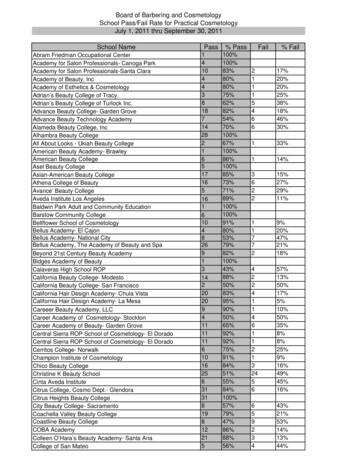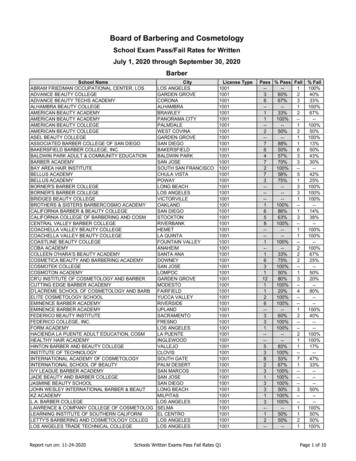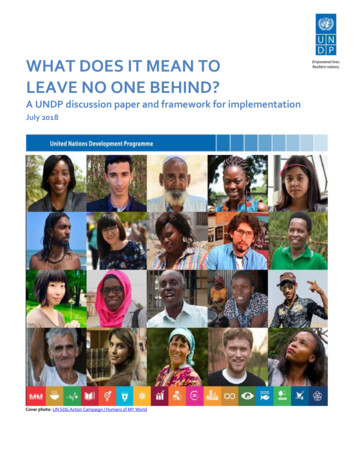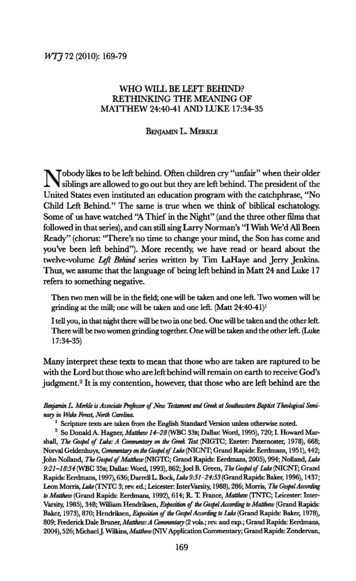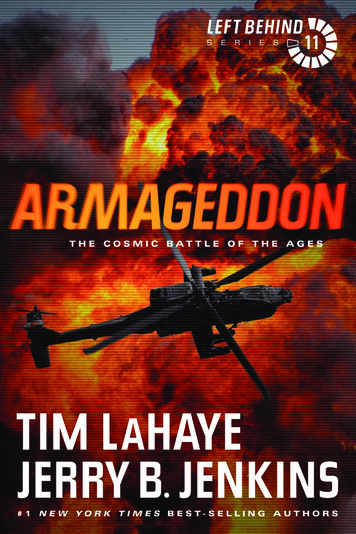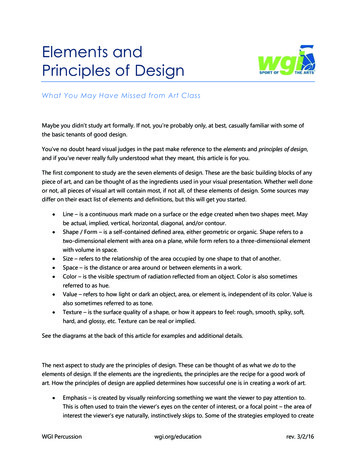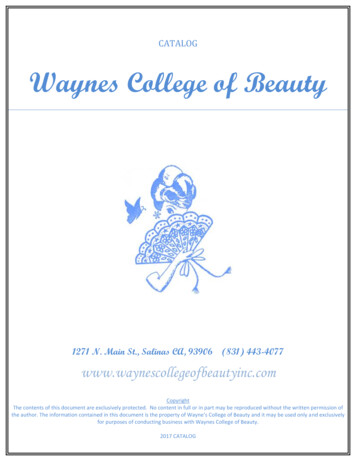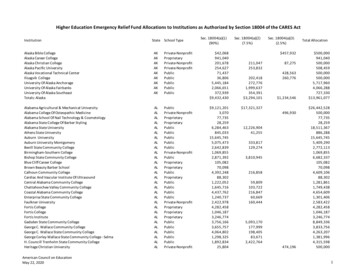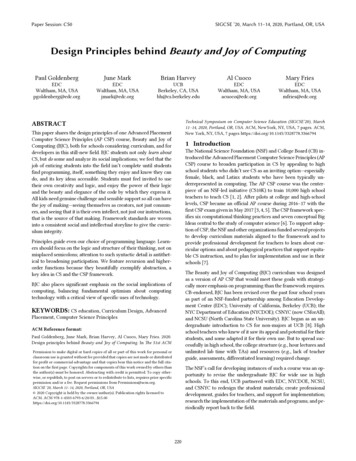
Transcription
Paper Session: CS0SIGCSE ’20, March 11–14, 2020, Portland, OR, USADesign Principles behind Beauty and Joy of ComputingPaul GoldenbergEDCWaltham, MA, USApgoldenberg@edc.orgJune MarkEDCWaltham, MA, USAjmark@edc.orgBrian HarveyUCBBerkeley, CA, USAbh@cs.berkeley.eduAl CuocoEDCWaltham, MA, USAacuoco@edc.orgMary FriesEDCWaltham, MA, USAmfries@edc.orgTechnical Symposium on Computer Science Education (SIGCSE’20), March11–14, 2020, Portland, OR, USA. ACM, NewYork, NY, USA, 7 pages. ACM,New York, NY, USA, 7 pages s paper shares the design principles of one Advanced PlacementComputer Science Principles (AP CSP) course, Beauty and Joy ofComputing (BJC), both for schools considering curriculum, and fordevelopers in this still-new field. BJC students not only learn aboutCS, but do some and analyze its social implications; we feel that thejob of enticing students into the field isn’t complete until studentsfind programming, itself, something they enjoy and know they cando, and its key ideas accessible. Students must feel invited to usetheir own creativity and logic, and enjoy the power of their logicand the beauty and elegance of the code by which they express it.All kids need genuine challenge and sensible support so all can havethe joy of making—seeing themselves as creators, not just consumers, and seeing that it is their own intellect, not just our instructions,that is the source of that making. Framework standards are woveninto a consistent social and intellectual storyline to give the curriculum integrity.1 IntroductionThe National Science Foundation (NSF) and College Board (CB) introduced the Advanced Placement Computer Science Principles (APCSP) course to broaden participation in CS by appealing to highschool students who didn’t see CS as an inviting option—especiallyfemale, black, and Latinx students who have been typically underrepresented in computing. The AP CSP course was the centerpiece of an NSF-led initiative (CS10K) to train 10,000 high schoolteachers to teach CS [1, 2]. After pilots at college and high-schoollevels, CSP became an official AP course during 2016–17 with thefirst CSP exam given in May 2017 [3, 4, 5]. The CSP framework specifies six computational thinking practices and seven conceptual BigIdeas central to the study of computer science [6]. To support adoption of CSP, the NSF and other organizations funded several projectsto develop curriculum materials aligned to the framework and toprovide professional development for teachers to learn about curricular options and about pedagogical practices that support equitable CS instruction, and to plan for implementation and use in theirschools [7].Principles guide even our choice of programming language. Learners should focus on the logic and structure of their thinking, not onmisplaced semicolons; attention to such syntactic detail is antithetical to broadening participation. We feature recursion and higherorder functions because they beautifully exemplify abstraction, akey idea in CS and the CSP framework.The Beauty and Joy of Computing (BJC) curriculum was designedas a version of AP CSP that would meet these goals with strategically more emphasis on programming than the framework requires.CB-endorsed, BJC has been revised over the past four school yearsas part of an NSF-funded partnership among Education Development Center (EDC); University of California, Berkeley (UCB); theNYC Department of Education (NYCDOE); CSNYC (now CSforAll);and NCSU (North Carolina State University). BJC began as an undergraduate introduction to CS for non-majors at UCB [8]. Highschool teachers who knew of it saw its appeal and potential for theirstudents, and some adapted it for their own use. But to spread successfully in high school, the college structure (e.g., hour lectures andunlimited lab time with TAs) and resources (e.g., lack of teacherguide, assessments, differentiated learning) required change.BJC also places significant emphasis on the social implications ofcomputing, balancing fundamental optimism about computingtechnology with a critical view of specific uses of technology.KEYWORDS: CS education, Curriculum Design, AdvancedPlacement, Computer Science PrinciplesACM Reference format:Paul Goldenberg, June Mark, Brian Harvey, Al Cuoco, Mary Fries. 2020.Design principles behind Beauty and Joy of Computing. In The 51st ACMPermission to make digital or hard copies of all or part of this work for personal orclassroom use is granted without fee provided that copies are not made or distributedfor profit or commercial advantage and that copies bear this notice and the full citation on the first page. Copyrights for components of this work owned by others thanthe author(s) must be honored. Abstracting with credit is permitted. To copy otherwise, or republish, to post on servers or to redistribute to lists, requires prior specificpermission and/or a fee. Request permissions from Permissions@acm.org.SIGCSE '20, March 11–14, 2020, Portland, OR, USA 2020 Copyright is held by the owner/author(s). Publication rights licensed toACM. ACM 978-1-4503-6793-6/20/03 15.00https://doi.org/10.1145/3328778.3366794The NSF’s call for developing instances of such a course was an opportunity to revise the undergraduate BJC for wide use in highschools. To this end, UCB partnered with EDC, NYCDOE, NCSU,and CSNYC to redesign the student materials; create professionaldevelopment, guides for teachers, and support for implementation;research the implementation of the materials and programs; and periodically report back to the field.220
Paper Session: CS0SIGCSE ’20, March 11–14, 2020, Portland, OR, USAGiven the range of options—now, a dozen curricula, varying in approach, all aligned with the framework [9] and endorsed by CB—wewant to share with schools, in the same spirit as [10], the underlyingdesign principles as schools consider these programs.curriculum can make everything from small details to major ideasseem equally important.In BJC, our absolute top-level goal is broadened participation in computer science. All by itself, that goal dictates several things. At a minimum, such a curriculum must avoid biases in culture, intellectualor social interest, or accessibility that exclude students even implicitly. It must also be computer science. It must present real but manageable challenge so that students feel the fun and exhileration ofcompetence and confidence that they can “do” computer science.That is, our way to serve the top-level goal is to entice students withthe pleasure and sense of agency programmers feel when they usetheir own creativity and logic to make things, and to let them enjoythe power of their own logic and the beauty and elegance of thecode they create to express it.When we originally proposed this work, we believed that most ofour attention would be on the structural elements and supplementary resources while course-content changes would only be neededfor compliance with the AP CSP framework [7]. We also anticipatedcleaning up writing and style, but only in a small way. In fact, thingsturned out quite differently.By the time we were examining the student materials closelyenough to fine-tune lesson by lesson, we began to see ways in whichthe epistemology did not reflect our principles, and we began to focus as much on issues of pedagogy and emphasis as on structure,resources, and compliance. The result is now one of the CBendorsed curricula for the AP CSP course and exam.To accomplish this, BJC emphasizes programming more than theAP CSP standards require. Simple code and basic CS ideas can dopart of that but, in our experience, big ideas (e.g., recursion andhigher order functions) and their power can be presented accessibly.These ideas, not just coding or its products, can fascinate studentsand catch their interest. Of course, there are many big CS ideas—abstraction, algorithms, parallel processing, distributed processing,object-oriented programming, the concept (and techniques) of debugging, and so on. Because it is impossible to teach them allequally, we had to make decisions both about what to teach andabout how to teach.What’s to be learned from curriculum designers? By the timea curriculum reaches schools, the result often hides the thought, discussion, decisions about content and pedagogy, initial crafting, trials, revision, editing, and so on that went into its development, andthe many contributors—content specialists, writers, classroomteachers, students, advisors, page designers, illustrators, editors,evaluators, and others—who tug in different directions. The processelements—having a vision and articulating it clearly, brainstorming,outlining, writing, designing format and layout, editing, field testing, revising, striving for equity, teaching in the classroom, assuringusability by teachers, assessing student progress, meeting requiredstandards,accounting for sustainability, and more—interact in complex ways. A myriad of decisions must be made, all of which collectively determine the final product.2 Pedagogical design principlesTo broaden participation, we must consider how we teach as wellas what we teach: believe in students, build experience, organizearound big ideas, let them learn by doing, provide beauty and joy.Design with conviction that all kids can do challengingthings. Reaching a historically excluded audience can tempt curriculum writers to assume that reduced contact renders the newaudience less capable than those who have already joined the clubwithout invitation or accommodation. That assumption is destructive. Yes, people who have been excluded from CS (whetherfrom external bias or from their own expectations) have oftenbeen implicitly or explicitly excluded from advantages in othersubjects, too, with consequent background gaps. And, yes, manyunderrepresented kids are also students whose native language isnot English and, therefore, find heavy text a barrier. So we try tokeep text light and limit prerequisite special knowledge, but without limiting challenge or depth. One principle of our curriculumdevelopment is that all kids can do challenging things, and that allcan figure out a great deal on their own. Because pace inevitablydiffers—sometimes because deep interest slows kids down to experiment more or speeds them up to find the next surprise, andsometimes because of hurdles that change how kids work—wemust provide approaches that are genuine challenges to all kids;we must also provide sensible support so all students can experience the joy of making, and the joy of seeing that it is their ownintellect, not our instructions, that is the source of that making.What guides the decisions? There are non-negotiables: content matter must not be factually wrong, text must be readable by the intended audience, and standards/frameworks can’t be ignored. Butotherwise, there are few absolutes. While there are certainly wrongways to proceed, there are many right ways. Our aim here is to clarify what kinds of decisions must be made, illustrate how we cameto particular ones, and show how philosophy, assumptions, and“high-level” decisions can affect curriculum design, in some casesright down to matters of “low-level” page-craft. The paths from vision to page and from principle to implementation are messy. Wedoubt that many visions survive whole by the time they’ve gonethrough the meat-grinder of what, for now, we’ll just call “practicalities.” The result often imperfectly represents the principles thatwere to guide it, but examining the principles can help guide otherdevelopment.All the principles we list below derive from our fundamental beliefthat curriculum inevitably teaches more than its list of contents [11,12, 13, 14]. Its organization and pedagogy also teach a point of view.For example, explanation followed by practice teaches a very different way of thinking than experience and experimentation followedby formalization and consolidation. Content can be arranged to emphasize theory or application, or the historical development or otherfeatures of a discipline. Without close attention to message, aExperience before formality. This epistemological principlehas guided our curriculum development in mathematics and in221
Paper Session: CS0SIGCSE ’20, March 11–14, 2020, Portland, OR, USAprogramming for decades [15, 16, 17]. Roughly, it involves givingstudents enough varied experience with a concept to let them create the abstraction, the concept, themselves, saving technical details like vocabulary, definition, variations, and so on untilstudents have built the basic concept. BJC employs this use-modify-create [18] paradigm. For example, very early in BJC, studentsload a fully-functioning project with three pieces of code:later after students have had time to explore ideas in the context ofremixing an established project.Ideally, each tool/technique is encountered in a more than one context, partly to feed the diversity of student interests—language, art,mathematics, building games or quizzes . Encountering the sametool/technique in multiple contexts also shows that it is not singlepurpose; it lets students abstract out the utility of the tool preciselyso that they can extend it to their own purposes. For example, inthis first stage of the gossip project, the use of lists is basic: at thispoint, a list is just a repository for content selected at random; noindexing, no construction of the list, no mapping over the list. Butthe idea grows to handle more complex language and to patch together parts of words. Students create a block that appends s to theend of a noun, then improve it so that it does a better job of makingplurals than just adding s. (Optionally, students use the same techniques to conjugate a verb in Spanish or another language of theirchoice.) The higher order function map lets them apply their pluralizer to a test-list of nouns. Lists keep appearing in differentways—lists of coordinate pairs, lists of embedded lists, lists of runnable blocks—and the powerful tools that process lists, like mappinga function over a list, or applying a predicate to all items of a list,and keeping only those items that fit—appear in semantically clear,syntactically simple contexts.,,.They click on each, using each to see what it does. The gossip blockreports a simple sentence. Then students open the blocks up to examine their structure (fig. 1). The structure is simple and the behavior they’ve seen in their experiments tells them what the codemeans. This is analogous to how children learn their native language, from use in context. Students modify the code—initially in analmost trivial way—personalizing it with their own content.A second gossiper (fig. 2) with a different vocabulary, not yet seenby the students, sparks curiosity and leads to new learning but isstill simple and clear. Some students use the pattern they see tomake the second gossiper invoke the first again, leading to a recursive back and forth. Despite having deliberately introduced a callback to the first gossiper, some students are surprised by the continued behavior; some anticipate only one extra step, and not a recurring one. Long before we formally “teach” recursion, students(possibly just by accident) invent it themselves, though not yet witha way to control it. A lot has happened in just this one early lesson.Students encounter lists (arrays), multiple agents each with its ownscript, some control structure and event handling. They can modifythese purposively before receiving formal instruction. And theyhave opportunities for surprise that build curiosity. Consolidation,extension, and explanation—formalizing the knowledge—all comeStudents encounter recursive processes early before studying thestructure of recursion in any formal way. They may have seen theback-and-forth caused by introducing broadcast to the secondsprite. They definitely replace the second who in gossip with morecomplicated who (fig. 3) which introduces a conditional, and thenthey replace one of the first two whos inside more complicated whowith more complicated who, try gossip a few more times, and describe the surprising result.Figure 3: Introducing a conditionand an informal opportunity for recursionFigure 1: The definitions of who, does what, and gossip.Preserve all required details, but organize around big ideas.Curriculum teaches more than content. When a constraint (e.g., aframework requirement) requires what feels like a loose factoid ora distraction from our goals (e.g., broader participation, personalpower, important and beautiful ideas) we must find a way to meetthe constraint in an intellectually or socially worthy context. Ignoring frameworks is no option; a curriculum that schools can’t acceptis ineffective; but weaving each standard into a consistent social orintellectual storyline gives a curriculum integrity.Then they try a two-block script.The behavior is a surprise (fig 2).Figure 2: Two sprites gossiping with different vocabulary.222
Paper Session: CS0SIGCSE ’20, March 11–14, 2020, Portland, OR, USAThe same principle guides the choice of programming language. Ifstudents are to experience the power and intellectual beauty of programming, then logic, not syntactic detail, must be the focus. Inmany text-based languages, a program can be completely logical instructure but fail to work because of a misplaced semicolon. Thoughprofessionals may have to develop skill at searching for syntax errors, we believe that is not where any beginners’ attention shouldbe, and is especially antithetical to broadening participation. Choosing Snap! as our language for instruction and work focuses students’coding and debugging time on the logic and strategies of programming, not syntax. Snap! is essentially Scheme [19] disguised asScratch [20]. On the one hand, it is a sophisticated programminglanguage with advanced logic and power—recursion, higher-orderfunctions, complex data structures (including lists that can containnumbers, words, other lists, and even blocks of code), object- oriented programming, and lambda—and has been applied even incommercial settings. On the other hand, its visual, blocks-based interface nearly eliminates syntactic fussiness; its visual metaphorsmake powerful ideas accessible even to beginners. And researchsupports such a choice: students in blocks-based classes outperformstudents in otherwise comparable text-based classes and expressgreater interest in future computing courses [21, 22].be uncluttered with the camouflage of context and other techniquesor tools. In those cases, we try to present puzzles for kids to solveusing the new tool. This one, inspired by Vaniček [23], teaches predicates by giving students code and a result to try to understand (fig4), and then new designs to try to make by using and modifyingother predicates (fig 5).Learning by doing. To a first approximation, CS is a body ofknowledge and ways of thinking that help people create hardwareand algorithms for solving problems like programming a machineto sort mountains of data or understand natural language or learnfrom “experience.” CS also builds languages that let people programto create things, tools for productivity, health, games, science, art .Programing is inherently creative, and learning to program is, bynature, hands on. That experience of making things, therefore,should be a big part of our students’ experience.Beauty and joy: helping students recognize, respect, grow,and enjoy their own logic and creativity in CS. The esthetic ofprogramming is not just in its products; programs, themselves, canhave intellectual beauty. The classic text, Structure and Interpretation of Computer Programs [24] says it this way:BJC uses the same strategy to introduce the higher order functionkeep, as students comb through a massive dictionary to createa list of words that match clues for a word puzzle.Puzzles need not be artificially crafted. They can be part of a project,but abstracted from the whole so that the focus is on the new element. Ultimately, to teach students how to think on their own, theprojects we present are incomplete, going only as far as the rawfunctionality of the new elements we are teaching so that studentsget the sense of what’s possible and the power they have to createit, but leaving room for them to add their own features creatively.We assure that they have all the essential tools (blocks), give themsome example, and then let them go.“To appreciate programming as an intellectual activityin its own right [ ] you must read and write computerprograms—many of them. It doesn’t matter much whatthe programs are about . What does matter is how wellthey perform and how smoothly they fit with other programs in the creation of still greater programs. The programmer must seek both perfection of part andadequacy of collection.” (Emphasis ours.)Designing learning around projects doesn’t mean that the objectiveis the project. If that were the goal, Lego-like instructions, explicitsteps to get a lovely result, would suffice. Instead, we want studentsto learn how to do their own projects—ones we have not thoughtof—to experience “I can create,” “I can solve problems,” “I can program.” That means they need to learn tools and techniques that letthem improvise. To us, project-based means learning importanttools and techniques not by doing exercises on them but by buildingthings that need them. That helps us define “important techniques”:ones that are re-usable. Some things we think are extremely coolcan’t be taught because they can’t be re-used within the limited timewe have. Showing many wonderful things, but giving students notime to assimilate and own them seems fruitless to us.The CSP framework emphasizes creativity. To serve this goal andbuild a sense of competence to pursue CS, our students experience“doing CS” through more programming than the CB requires. Tohelp them feel “CS-smart,” students need to see their code not justas a means to an end with an effect they like but as “poetry,” codewith structure, elegance and power. Programs represent students’thinking, so the code, itself, should feel beautiful to students.Achieving and appreciating beautiful code isn’t about being clever.Cleverness is a local phenomenon that appears differently in eachstudent. Our goal is to help students express the beauty in their insights, without having to worry about computerish details. Wewant to let programming help them refine and add precision bothto their insights and to their expression. For example, there aremany ways to define a function that takes a list of numbers as inputand returns a list containing the squares of those numbers.Students see that their own work can always be extended and improved. Some projects appear in stages. You can do this part now,with what you know. Later, when you know more, you can add toit. A more general message is that work is never “done, but bad”;work that is not yet as one likes is simply not yet done. And there’sno perfect state; things can always be revised.Figure 6 shows three methods for a squares ofblock. Two closely mimic how students often describe their thinking; the third uses a style thatfew students articulateProject orientation does not mean there are never etudes along theway. Though we may generally strive for introducing new techniques or tools in the context of needing them for some purpose weare already engaged in, sometimes learning the new ideas needs to223
Paper Session: CS0SIGCSE ’20, March 11–14, 2020, Portland, OR, USAspontaneously. While attracting students to the field, we don’t pushparticular techniques—students will, in time, develop their ownstyle and esthetic—but to develop a personal style, or even to noticethat there can be a poetry in programming, they need at least someexposure to varied approaches to a single problem.Design for diversity by offering diversity and personalization. A curriculum cannot be completely bias-free. The tone, contexts, even the content one chooses to highlight, all evince a pointof view that is not universal. Some curricula attempt inclusivity byusing culture-stereotypical names, contexts or activities—pop-socialimages of “boy” and “girl” or “white” and “black” culture, or cultureassociated names. We think this is not a good way to be inclusive,reduce bias, or broaden appeal. While such techniques explicitly signal acknowledgment of diverse groups and sensibilities, they do soby invoking stereotypes: this project is here for girls; this name (ostentatiously) reflects your ethnicity.So? Avoid imagery, style, or content that implicitly targets a grouppro or con. But there are also more subtle biases. We recall BarbaraJanson [25] describing her visit with a teacher group who knew thatthe math text they had was rote, non-thinking junk, but saw no helpfrom the new materials they were shown because of the materials’strong (liberal) cultural bias: boys doing dishes, “rain forest math,”and so on. Though this bias probably wasn’t accidental (surely itreflected a conscious concern of the university R&D teams that builtthe curricula), its consequences included one that the developerssurely didn’t intend: It left some groups unserved. But even a naïveaccident can create bias. “Mary went to the clothing store with 200and wanted to .” And of course cultural/political neutrality is alsoa bias—a choice not to take certain stands, resulting in a bias towardthe status quo.Figure 4: A script and its result.We take the deliberately non-neutral stand of aiming to attract andserve the most underrepresented groups in CS. We actively recruitto get kids in, then let word of mouth draw in more. The BJC principle (not fully realized) is to appeal to a breadth of personal, socialand intellectual interests that cross race, gender, and economic lines(mathematics, language, games, art, science ) and leave room forstudents to put their own stamp on their work.Figure 5: A design and some predicates that might help.3 Content principles: ProgrammingHelping students see that they can “do” CS and enjoy it is one partof our strategy. We also invite students beyond the entry points,experiencing recursion and higher-order functions because of thepowerful and beautiful way they exemplify abstraction, a key ideain CS and in the AP CSP framework. Such “advanced topics” areoften seen by others as too difficult for students, but Snap!’s explicitvisual representations make them more accessible. Seeing the complexity of a fractal tree (or being taken by surprise by an astonishingly long gossip) and seeing the simplicity of the recursiveprocedure that produces it is an “aha!” that you don’t get from aGoogle search, a video, making a poster in Photoshop, or even writing programs with no control structure more powerful than a loop.We’ve mentioned some of these “extra content” choices before, sothis section will be light, but we want to clarify why we think thesematter even in an introductory CS experience.The power of recursion. One important face of abstraction occurs when you notice that in some problems, parts mirror the same steps as the whole. Forexample, in this design, seen very early in BJC without complex trappings, whatever process draws thered triangle and its blue children could conceivably let blue trianglesFigure 6: Iterative, recursive, and higher-order functionapproaches to processing a list.224
Paper Session: CS0SIGCSE ’20, March 11–14, 2020, Portland, OR, USAdraw green children. After multiple early experiences that clarifythe idea, we teach recursion formally late in the course, analyzingwhat enables it (the recursive call) and what stops it (base case) using both graphical (e.g., fractal trees) and list or number processing(with memoization, if needed). Modeling the reasoning with a recursive program helps develop such thinking.Everyone can participate in developing technology policy.Even apart from being the programmers, students learn that theycan control the development of new technologies simply by beingaware voters and consumers. BJC students read, discuss, and writeabout issues of computing in society using the Blown to Bits book[26] and regularly engage in “Computing in the News” activities, inwhich students present a recent article about technology, and theclass asks clarifying questions and discusses implications.Function as data. Another important face of abstraction occurswhen methods become objects. In mathematics, one engine for progress is that the methods of one generation become the objects ofstudy for the next. Like Scheme, Snap! implements “first class functions.” Students first see functions as inputs with semantically clearexamples. Using map to test plural is one; here is another.Teaching social implications is not “teaching ethics.” Much ofthe teaching about social topics, especially in K–12 but even at theuniversity level, takes the form of shalt-nots: Don’t download illegalcopies of movies and music. Don’t cyberbully. We prefer to respectstudents as thoughtful social agents and to inform them about theimplications of technology for different stakeholders rather than tolay down rules.When students study recursion formally, they learn to build map.For example, students work in groups to try to develop a way forauthors to make a living from their work while still allowing theunlimited downloading rights that many students want, and whilerespecting the original public interest purpose of copyright. Theyalso consider how making movies, with a cast and crew of thousands, needs a different financial model from making music, whichmay be created by a single person.5 ConclusionGiven the growth in interest in introducing and engaging K–12 students in computer science, particularly among high school students,many teams have designed materials to serve this goal, resulting indiverse curricular options for teachers and schools to learn aboutand choose among, all aligned with the new AP CSP framework a
the joy of making—seeing themselves as creators, not just consum-ers, and seeing that it is their own intellect, not just our instructions, that is the source of that making. Framework standards are woven into a consistent social and intellectual storyline to give the curric-ulum integrity. Principles
